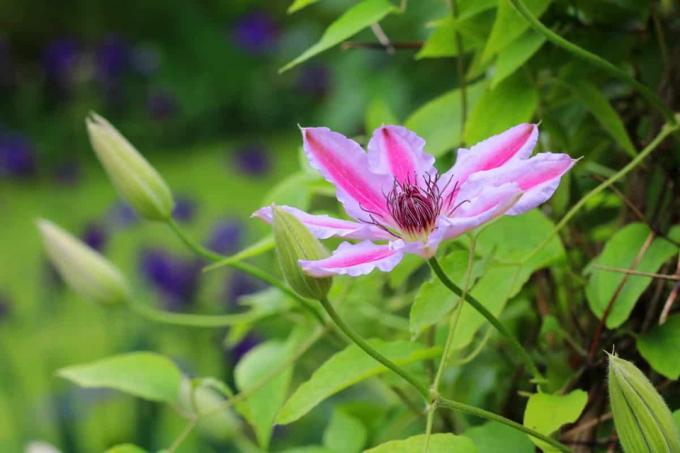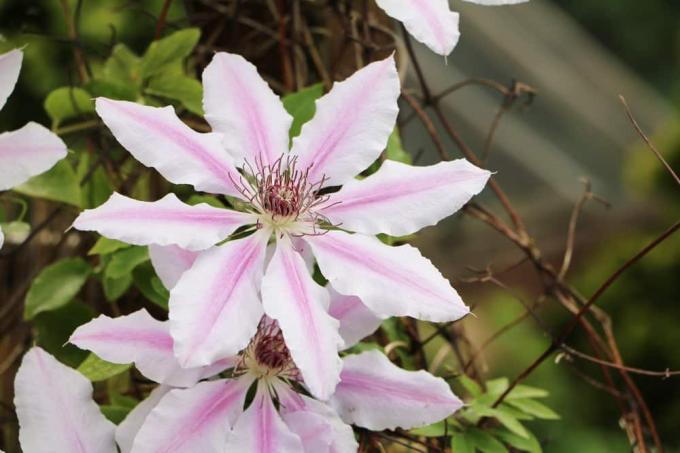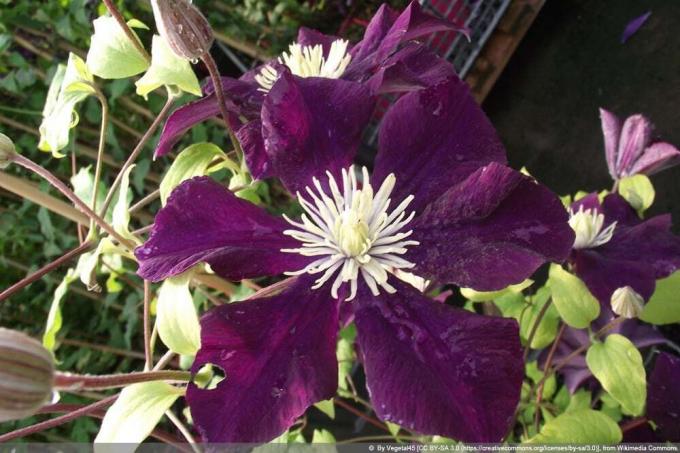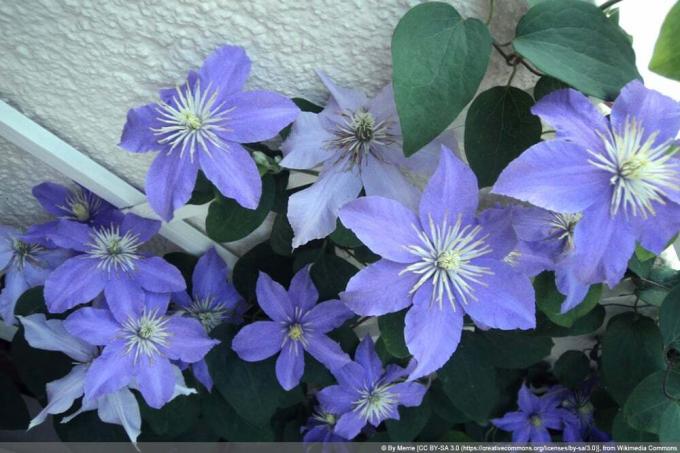

Table of contents
- Clematis wilt, what is that exactly?
- The phoma wilt
- Which clematis varieties are susceptible to Phoma wilt?
- Discover Phoma wilt in good time
- Successfully combat Phoma wilt
- The Fusarium wilt
- Which clematis are affected by Fusarium wilt?
- Discover Fusarium wilt in good time
- Successfully control Fusarium wilt
- Successfully avoiding wilt
- Choose hardy species
There are plant diseases, waiting won't help. Clematis wilt is such an insidious fungal disease. Out of the blue, she strikes quickly and mercilessly. If you take your time fighting them, you've already lost the fight. It is therefore important to react quickly. The climbing artist should recover and continue to do her flourishing work. With the right measures, this request is by no means hopeless.
Clematis wilt, what is that exactly?
Clematis wilt is a disease caused by fungal pathogens. The spores of the fungi are already in the soil, just waiting for an opportunity to attack the clematis plant. Vacancies caused by injuries are welcome entry points. After infesting the plant, they unleash their devastating effects without much delay and at a breathtaking pace. However, two different diseases are hidden under the name clematis wilt. They are caused by different fungal pathogens and also differ in the later course of the disease. The two types are:
- Phoma wilt
- Fusarium wilt
It is important to differentiate and clearly identify these two species. The type of wilt has a significant impact on how to combat it.
The phoma wilt

Phoma wilt is the most common wilt. The damage is similar to that of leaf spot disease. That's why it's crucial to take a second look at the diseased vine. Because while leaf spot disease is unsightly but harmless, Phoma wilt must be taken seriously.
- The cause is the fungal pathogen Ascochyta clematidina
- first signs appear in May or June
- ground level and older leaves are affected first
- small, round and tawny spots appear on leaf undersides
- Spots become larger, darker and more misshapen
- they continue to spread to the leaves
- the affected leaves eventually die
- warm, humid climate favors the spread
The fungus also spreads in the shoots and stems, which of course cannot be seen with the naked eye.
Which clematis varieties are susceptible to Phoma wilt?
The original clematis varieties are not left out by the Phoma wilt. However, the clinical picture is limited. Usually the disease does not get beyond the stage of small spots. This course of the disease is harmless to the plant. But what about the numerous hybrid varieties? These are often found in our gardens because of their large and mostly double flowers. Here, as a rule, the fungus completely destroys all aerial parts. Especially with these beautiful varieties, control is necessary so that the damage is minimized or prevented. the complete death of the climbing plant is prevented.
Discover Phoma wilt in good time
The wilt spreads quickly. Hardly two weeks pass from the first signs to the death of entire shoots. Rescue measures can only be effective in the early stages of the disease. It is therefore important to detect the infestation early. This should not be left to chance, otherwise any help could come too late for the clematis.
- Inspect the vine at regular intervals
- from mid-May at short intervals of a few days
- pay particular attention to the older leaves in the lower third of the plant
Successfully combat Phoma wilt

As soon as the first signs of wilting appear on the clematis, immediate action should be taken.
- remove all withered leaves immediately
- if necessary, whole shoots must be cut off
- Pick up any fallen leaves from the ground
- Removed plant parts belong in the residual waste
- Plant parts affected by fungus must not be composted under any circumstances
- spray the pruned vine with commercial fungicide
Tip:
After cutting off diseased shoots, be sure to clean and disinfect the cutting tool used so that any fungal spores adhering to it are completely removed.
How quickly the creeper recovers depends on how far the disease has progressed. If the fungus has not yet reached the inside of the plant, the clematis will quickly recover. Otherwise, the plant can often no longer be helped with fungicides. Sometimes, however, it can happen that the clematis survives the complete above-ground death. After about three years it drives out again. If you want to experience such a positive surprise, you should leave the roots in the ground and not dig them up.
The Fusarium wilt
The less common Fusarium wilt, also known as fusiarose, is caused by a slime mold called Coniothyrium clematidis-rectae. He uses the smallest injuries to the plant to get into its pathways from the outside. From there, it spreads throughout the plant's supply system, clogging parts of it.
- Plant parts above the affected areas suffer
- they no longer get enough water
- nutrients can no longer reach them either
- as a result of the lack of supply, they wither and die off suddenly
- Leaves initially get a brown edge
- Margin spreads further towards the middle of the sheet
Which clematis are affected by Fusarium wilt?
Basically, any clematis can suffer from this wilt. However, some clematis plants are particularly susceptible because they are not sufficiently resistant or offer an unprotected target. These are as follows:
- large-flowered varieties
- young plants
- old clematis
- Climbing plants weakened by care errors
- Plants with damage to their young shoots
Tip:
When gardening, be careful not to accidentally damage the plant. Because their tendrils are thin, they can easily be torn off.
Discover Fusarium wilt in good time

With this type of wilt, too, it is useful to detect its signs as early as possible through regular assessment. But unlike Phoma wilt, this disease occurs a little later. These fungal pathogens like warmer weather with temperatures above 20°.
- first signs can be expected from mid-June
- single shoots that suddenly wither for no apparent reason
A notice:
Wilting shoots are quickly interpreted as a sign of a lack of water. The vine is then watered. However, if this is a result of Fusarium wilt, this watering will not bring any improvement. Valuable time is lost if appropriate action is not taken.
Successfully control Fusarium wilt
There are no effective fungicides available to control Fusarium wilt. It is all the more important to take alternative control methods immediately. Here, too, garden shears must be used consistently. However, it is not enough to just remove the withered parts of the plant.
- a radical cut is unavoidable
- all shoots must be cut off close to the ground
A notice:
In order to avoid further infections, care must always be taken to thoroughly disinfect the equipment used when cutting diseased plant parts. Both before and after the divorce.
So that the fungus cannot strike again, all above-ground parts must be completely and safely disposed of. The ground must also be checked for old, fallen leaves. The pathogen can still adhere to them, they too must be collected and destroyed. If the disease is discovered at an early stage, there is a good chance that the vine will recover. Since the fungus does not penetrate the root area, new shoots can sprout from them after a while.
Successfully avoiding wilt
The best protection against both types of wilt is not to let it get that far in the first place. The possibilities of successful prevention start with planting and continue with ongoing care. Plants that grow in a suitable location and receive optimal care are stronger and more resistant to this pathogen.
- only strong plants, buy in 2-3 liter containers
- the best location is protected from wind, rain and sun
- Plant root ball deeper
- when planting on the wall, make sure there is enough space between them
- always observe the rules of care
- Drainage prevents waterlogging
- Never rake the soil, roots and shoots can be damaged
- water in the root area, never over the leaves
Choose hardy species

Some original clematis species have proven to be quite resilient. Many new breeds have also specifically focused on resilience. If you want to be on the safe side, you can use these varieties right from the start.
- original varieties from the Italian Clematis Viticella group
- large-flowered hybrids such as spring-flowering 'Multi Blue' and 'The President'
- summer flowering clematis: e.g. B: 'Comtesse de Bouchaud', 'Ville de Lyon' or 'Yukikomachi'
 garden editorial
garden editorial I write about everything that interests me in my garden.
Learn more about clematis

Lice, beetles & co: common clematis pests
Above and below ground there are many pests that can pose a threat to clematis. Without suitable countermeasures, some pests can damage a magnificent perennial so much within a few days that it dies.

Pruning clematis: Instructions for late and early flowering varieties
Clematis is known and loved for its diverse flower shapes and colors. The plants, also known as clematis, are extremely decorative plants that can be used in many places in the garden to green trellises, pergolas, arbors and walls.

Clematis 'Warszawska Nike' Warsaw Night - care and pruning
The Clematis 'Warszawska Nike' Warsaw Night scores with its flowers. With the easy-care climbing plant you definitely get an eye-catcher in the garden. Only the cut is a bit difficult and requires courageous access. More about this is here.

Clematis 'Justa' clematis - profile, care and cutting
Clematis 'Justa' clematis is a dwarf variety that has strong growth. In the summertime, the plant adorns itself with beautiful purple flowers that can also shine light blue. The clematis grows climbing and can reach a considerable height.

Clematis 'Nelly Moser' - pruning and care from A-Z
The clematis 'Nelly Moser' inspires with delicate pink flowers. A strong violet central stripe on each petal and the red stamens add harmonious color accents. In May and June, it unleashes a veritable explosion of flowers. With proper care, it also gives away a second bloom.

Clematis 'Piilu' clematis - profile, care and cutting
Clematis 'Piilu' is a particularly attractive and floriferous representative of the clematis. Its large, plate-shaped flowers captivate with an extraordinary color brilliance in dreamlike pink to violet and a second bloom until September.
